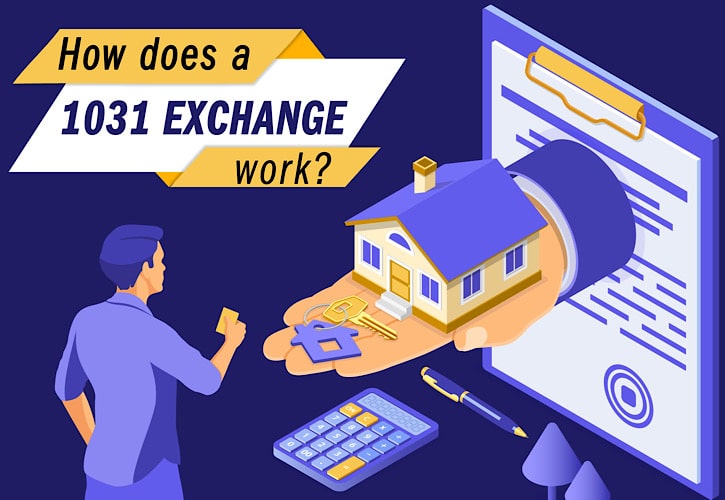How to Make the Most of Your Real Estate Investments with a 1031 Exchange
An investment strategy that has been gaining in popularity in recent years is the 1031 exchange.
In short, a 1031 exchange is a way to defer the capital gains tax on an investment property that you sell, as long as you reinvest the proceeds in a “like-kind” property.
This type of transaction can be advantageous if you want to stay invested in the real estate market but don’t want to pay the capital gains tax.

A common misconception about 1031 exchanges is that they are only for rich investors, but the reality couldn’t be further from the truth. Anyone can set up a 1031 exchange as long as they meet the requirements and follow the rules.
However, because this process requires specific steps, it would be wise to consult with a real estate professional before embarking on it.

In this article, we will take a closer look at 1031 Exchanges and answer some of the most common questions, including:
- What are the benefits of doing a 1031 Exchange?
- Who can participate in a 1031 Exchange?
- What are the rules and regulations for a 1031 Exchange?
- How long do I have to reinvest the proceeds from the sale of my property?
What is a 1031 Exchange?
You might have heard the term 1031 Exchange as a real estate term bandied about by real estate investors. But what is a 1031 Exchange, and what do regular would-be investors need to know?
Put simply, a 1031 Exchange is a tax deferral strategy used to avoid paying taxes on the capital gains of an investment property that has been sold.
The IRS (Internal Revenue Service) states that: “You can postpone paying tax on any gain from the sale of your property if you buy replacement property within a specific time frame.”
This is done by reinvesting the sale proceeds into a “like-kind” property – for example, you could reinvest in another rental property.

For example, if you have sold a home in the last several years, you may have been aware of the tax rules, which indicate that as long as a seller used their home as a primary residence for two of the last five years, they would not be taxed on the first $250,000 of capital gains when sold ($500,000 for couples).
Meaning, if you purchased a home for $100,000 ten years ago, lived in it for at least two of the last five years, and sold it for $300,000 last year, you would not owe capital gains tax on the $200,000 gained.
On the other hand, if you bought a new home for $300,000 last year and sold your old one for $200,000 this year (after living in it for all five years), you would owe capital gains tax on the total amount of money gained.
However, if you meet certain requirements under Internal Revenue Code Section 1031, you can defer the taxable gain from the sale of a capital asset.
In other words, you would not have to pay tax on the $200,000 until you sold your new property down the road.
This type of trading is what qualifies as a 1031 Exchange under US Tax Code Section 1031.

What About Inherited Property?
Inherited property can also qualify for a 1031 Exchange as long as it meets the same requirements. If someone sells inherited property, the value is considered “stepped up” to reflect current market value.
For example, suppose someone were to inherit their parent’s home and the home has a current market value of $400,000 when inherited.
In that case, capital gains are only calculated on this value, not on the value when the parents originally purchased it. If this person who inherited the home rented it out for three years and sold it for $475,000, they would owe capital gains, but only on $75,000.
In theory, a 1031 Exchange is similar to both of these scenarios combined in that it allows the investor to defer capital gains on an investment property by reinvesting those assets.
One can invest in multiple 1031 Exchanges until death, passing on those assets to their heirs, who then inherit these on the afore-mentioned stepped-up basis.

Who Can Participate in a 1031 Exchange?
The IRS has outlined particular rules that must be followed when completing a 1031 Exchange.
First and foremost, the property being sold must be a “capital asset.” This generally means that you cannot sell inventory, equipment, or other business assets – though there are some exceptions.
In addition, you must reinvest the proceeds from the sale of the property into a “like-kind” investment.
For example, you could not reinvest in stocks if you sold a property held for investment purposes.
The rules also stipulate that individuals must identify the new property within 45 days of the sale of the old one, and the purchase of the new property must close within 180 days.
There are some other restrictions, but these are the most important ones to keep in mind.
It’s also important to note that investors can use a 1031 Exchange with both personal and investment property. For investors who have received rental income, this is a great way to stay invested in the market while saving on capital gains.
As with any tax-related matter, talking to your financial professional and an experienced real estate agent before moving forward is essential.

What Are The Benefits of a 1031 Exchange?
There are several benefits to using a 1031 Exchange:
1. Capital Gains Deferral
One of the main reasons that people use 1031 Exchanges is to defer capital gains taxes.
This can be extremely useful for investors who expect to earn similar amounts of money on their investments over the next several years or if they plan on using other investment assets as part of their strategy moving forward.
However, it’s important to keep in mind that the taxable gain will have to be paid eventually, even if it is deferred. But a 1031 Exchanges lets you reinvest the money – which can help increase your bottom line.
2. Keeping More of Your Investment Capital
Another reason that investors love 1031 Exchanges is that they can keep more of their money invested in the market. Often, you may need to sell an investment if it’s not performing as well as expected (or as initially planned).
However, with a 1031 Exchange, you can simply find a new property to invest in and avoid having to pay taxes on the sale.
This is a great way to stay invested in the market and build your portfolio.
3. Tax-Free Reinvestment
As mentioned earlier, when you reinvest the proceeds from a 1031 Exchange into a new property within the parameters outlined by the IRS, this entire transaction is essentially tax-free.
If you were to sell an investment property and use that money for other investments or personal purchases, you would have to pay capital gains taxes on any amount over $250,000 if married filing jointly (or $500,000 if single).
However, you pay no taxes since you reinvest the proceeds into an entirely new property with a 1031 Exchange. This is especially useful for investors who are looking to maintain their portfolio but want to avoid having to pay capital gains in the near future.
4. Diversification
While most people think of real estate when they hear about 1031 Exchanges, investors can use this type of transaction with any type of investment asset.
For instance, you could reinvest in stocks, bonds, or even other real estate properties if you so choose. This is a great way to stay invested in the market and diversify your portfolio.
5. Increased liquidity
When selling an investment property, you may have to wait a while for it to sell. This is especially true if the market is slow or the property is not in a desirable location.
However, with a 1031 Exchange, you can find a new property to invest in almost immediately. This can be extremely helpful if you need to quickly cash out on an investment.
6. No Age Restrictions
Unlike IRAs and other retirement accounts, there are no age restrictions on 1031 Exchanges. This means that you can use this type of transaction to help you save for retirement – even if you’re not quite there yet.
7. Estate Planning
A 1031 Exchange can also be used as a part of your estate planning strategy. If you want to pass on an investment property to your heirs, you can do so while avoiding capital gains taxes.

1031 Exchanges: Benefits with Rules Attached
There are stringent 1031 Exchange rules that you must meet to avoid capital gains tax:
Properties Must Be Designated As “Investment” Properties
First, both the “Old” and “New” properties must be investment properties. Rental property, bare land, or vacation homes are examples of these. In most cases, one can sell any property (such as an apartment building) and buy another property (perhaps an office building).
Properties Must Be Identified Within 45 Days
From the closing date on the sale of the old property, the investor has 45 days to determine potential properties to buy. This is also known as the “45-day list”. Investors should identify several potential properties to allow some not to be feasible investment options.
The buyer has 180 days to close whatever they are buying from the closing date, which must have been included on the 45-day list.

A Qualified Intermediary Must Be Involved
Those using a 1031 Exchange must engage a Qualified Intermediary (QI) to handle the exchange.
By law, the proceeds from the first property must be held by this “Qualified Intermediary” (sometimes also called an “Accommodator” or a “Facilitator”) who is also responsible for the preparation of paperwork required by the IRS to document the exchange.
You Can’t use the Properties For Personal Use
The 1031 Exchange rules are very clear that investors cannot use the properties involved in the exchange for personal purposes.
This means that you can’t live in the “Old” property and then use the proceeds to buy the “New” property. Nor can you use the new property for personal purposes. You must use the new property strictly for investment purposes.
All Cash Received Must Be Reinvested
If the entire purchase price of the new property is not paid in cash, then the 1031 Exchange rules require that all cash received must be reinvested into the new property.
For example, if a buyer receives a 1031 Exchange and wants to finance a portion of the purchase price, they must do so through a third-party lender. The 1031 Exchange rules require that investors must use the money from the sale of the “Old” property to buy the “New” property.

Proceeds Cannot Be Invested in Leverage
The 1031 Exchange rules prohibit reinvesting the sale proceeds of an old property into a new one unless the cash is used to purchase what are called “like-kind” properties. Therefore, there is no substitution of debt for equity with the 1031 Exchange rules.
No Profit/Loss Recognized on the Exchange
Finally, using a 1031 Exchange means no tax is due on capital gain because there’s no “recognition of gain.” The entire transaction must be documented and reported to the IRS via Form 8824. As a result, this helps you defer taxes on the sale of the old property.
Get Started With An Experienced Agent
A 1031 Exchange is a popular transaction that you can make with your real estate investments, but it’s important to know the rules and regulations before diving in!
This type of exchange is done to defer the capital gains tax, stay invested in the market, and diversify your portfolio. Individuals must follow certain rules and regulations, so it’s essential to know all the details before making this transaction!

Hi! We’re Josh and Jolene Baijot, the creators of this website. We’re also commercial real estate brokers in Bellingham, Washington. Thank you for taking the time to read this blog post. We appreciate your time spent on this site. You can connect with us on Facebook, Instagram, or contact us through this website.
Keep Reading
How to Buy Commercial Real Estate – A Beginner’s Guide
There are few investments as enticing and complex as commercial real estate.
By investing in commercial real estate, you can enjoy various benefits, including
increased income, appreciation in value, and diversification.
How to Buy Commercial Real Estate
It’s easy to hop online and start looking at properties you may want to purchase.
However, before you start investing in commercial real estate property, begin
investing in your commercial real estate knowledge.
Whatcom County Commercial Real Estate




